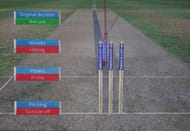The advent of technology

The advent of technology has changed the way cricket is played and viewed by spectators around the world. From giant-screens to Spidercams, it has also completely changed cricket broadcasting and enhanced the viewership experience.
For instance, unlike in the 90s and early 2000s, the third umpire’s decision is now no longer communicated by a red or green light but by the words ‘OUT’ or ‘NOT OUT’ distinctly displayed on the giant screens.
But technology has also made life easier for the umpires and made decision-making much more accurate. The best example is the Decision Review System or the DRS which was first introduced in ODI cricket in 2011.
It was first made mandatory and then optional which meant that it can be used in a bilateral series only if both the teams agree to use it. The various components of the DRS are ball-tacking which is used for LBW decisions, Snickometer which was later done away with, the Hawk-Eye.
The DRS has been mired in controversy since its inception with BCCI complaining time and again that technologies like the Hawk-Eye and ball-tracking are far from accurate. Currently, in ODIs, one review for each team is allowed for each innings which they get back for each successful challenge.
Looking for fast live cricket scores? Download CricRocket and get fast score updates, top-notch commentary in-depth match stats & much more! 🚀☄️
